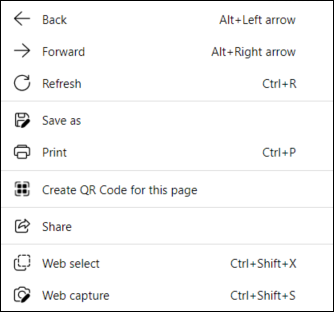Using the Web browser control at run-time
For security, the Web browser control does not include the open navigation and setting features of a standalone web browser app. The only ways for the run-time user to interact with the control are
Keyboard accelerators
If enabled in the Web browser control configuration, the following accelerators are available.
| Key | Description |
| Escape |
Stop content loading |
|
Ctrl+F |
Find on Page |
|
Ctrl+G |
Find Next |
|
Ctrl+Shift+G |
Find Previous |
|
Ctrl+P |
|
| Ctrl+R, F5, Reload Key | Reload page |
| Ctrl+Shift+R, Ctrl+F5, Shift+F5, Ctrl+Refresh, Shift+Refresh | Reload page and refresh cache |
| Ctrl+- | Zoom out |
| Ctrl++ | Zoom in |
| Ctrl+0 |
Reset zoom |
|
F3 |
Find next |
|
Shift+F3 |
Find previous |
| Alt+left arrow | Back |
| Alt+right arrow | Forward |
| Ctrl+Shift+I | Open / Close DevTools |
|
Ctrl+Shift+J |
Open DevTools console |
| Ctrl+Shift+C | Open DevTools inspect |
Context menu
If enabled in the Web browser control configuration, the following context menu commands are available. ![]() Show picture
Show picture
The commands correspond to accelerators, plus the following.
-
Save as - Allows you to save the web browser contents as an HTML file.
-
Create QR code for this page - Generates and download a QR code for the page Url.
-
Share - Share the Url of the page using various communication and social media apps. Outlook, twitter, Facebook, etc.
Some of the commands from the context menu permit access to the host computer resources - Windows Explorer, social media accounts etc. For security purposes you may want to disable this.
